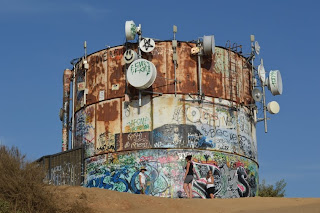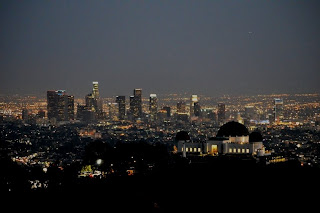Saturday was our semi-annual Mojave National Preserve Conservancy star party. We had a clear, slightly cool, and windless night--pretty darn perfect conditions. I had moderate success with my relatively new Meade LX80 mount. I may post more about that in my sidewalk astronomy blog.
Sunday morning, I got a late start. I was debating on this. Usually, on the morning after our star party, I leave early, get my hike in, and miss the post-star party breakfast. That's so I can get back not too long after most every body has eaten breakfast, so my wife doesn't get stuck waiting by herself for long. But, on this day, I stayed for breakfast with our friends, which meant I didn't start my hike until about 10am.
Woke up much earlier than that, though. Enjoyed the sight of the morning light hitting Table Top Mountain (picture at the top of this post). I hiked that last April. Before breakfast, I also set up my solar telescope tandem for folks to get a peek at the sun before heading off for home. It was the same set up I used at Cedar City earlier in the year, and for the Venus Transit I watched from La Canada in June.
From the visitor center at Hole in the Wall, I hiked to and through the Hole in the Wall camp-ground. The Barber Peak Loop trail is probably a bit longer this way than if I had done it the right way, though it's the same way I did this hike the other time I walked it, almost two years ago.
 At the north end of the camp-ground, there's a trailhead marker. The trail heads straight on north, then bends to the west, climbing towards the cliffs. It appears Barber Peak is a part of this mesa. Or perhaps it's the whole mesa. Unfortunately, I don't have a map that actually identifies the peak.
At the north end of the camp-ground, there's a trailhead marker. The trail heads straight on north, then bends to the west, climbing towards the cliffs. It appears Barber Peak is a part of this mesa. Or perhaps it's the whole mesa. Unfortunately, I don't have a map that actually identifies the peak.Most of the way from the camp-ground until after you've made it around to the north end of this mesa is a climb, although you do drop into a wash or two. You are rarely out of sight of a trail marker. Because of the crisscrossing old dirt roads, active dirt roads, use trails, cattle trails, deer trails, and who knows what else, the signage is helpful in keeping you on the right path.
Looking to the east, the sun cast layered shadows on the mesa walls in the distance. As I rounded towards the west, I looked east, and saw a back lit beaver tail cactus
Once on the north and heading down, you come across one of the larger "concrete" areas of the trail. It's a natural concrete--volcanic ash that became cemented, to the point where it really looks like someone just poured it out on to the hill. There are several other points along the way with concrete outcroppings.
The trail then heads west, then southwest. As you start heading southwest, you begin crossing what was once a dense pinyon pine-juniper forest. Regrettably, it, like the forest on Table Top Mountain, was burned a number of years ago. It actually looked a lot nicer now than it did two years ago, though.
As the trail heads to the south, you are frequently within sight of a dirt road. There's no pavement visible, though. And, in fact, if you just got dropped here, it might not be obvious how close you are to pavement. Between mesas, there's a definite sense of isolation.
Making my way to the south, I passed a pair of cows. I could swear these were the same cows I saw 18 months ago.
In addition to the dirt road and the several trails, there's also a dry river bed that runs along the way. Along this segment, I passed a couple of what could probably be considered "artifacts," though they were originally trash. Funny how NPS policy prohibits you from leaving new trash, but also prohibits you from taking old trash. ;D
Near the end of the southerly part of the trail, you pass near the Opalite Cliffs, an impressive outcropping of white and brown. They look clayish, though they could also be made of the same cemented ash that the other white outcroppings in the area are made of. I didn't immediately run across any quick on-line description of what they're made of.
From there, the path starts an easterly or southeasterly path. Before long, the trail makes a sharp left turn, up a hill. Had you gone forward, there would have been a substantial drop where the wash rushes down towards Wild Horse Road. I suspect this way is passable, but did not investigate carefully.
Instead, I stayed on the signed trail. It climbed (as I knew it would) up towards a gate. This incline is the start of a section of very thick cholla and barrel cactus growth. The portion of the trail immediately before here also had several burned skeletons of cholla.
This is the prettiest part of the hike, and probably what much of the last two miles would have looked like if not for the recent fire.
From the gate (intended to keep cattle on their designated allotment), it's mostly downhill towards Hole in the Wall. Expansive views to the south are also there to be enjoyed.
As the trail swings towards Hole in the Wall, I was again impressed by how impene-trable the wall appears. Yet, the trail heads straight in, and leads you up one of the chutes. Fallen boulders and metal rings provide the way through.
I thought the rock at the top of this cliff looked a little like a cross between George Washington and Abraham Lincoln.
Also in this little slot canyon segment, I saw a whiptail lizard. It wasn't the first lizard I saw this day, but it was the only one that stuck around to be photographed.
By the time I was inside this slot canyon and heading up the rings, I was tired and ready to go home. Didn't take any pictures after the lizard. Shoulda worn a hat. Pictures of that section of trail are in my previous blog of this hike, linked above, and here.
Now on the top of the slot canyon, I passed a sign indicating a possible ring-assisted path to a viewpoint atop this canyon. Not sure--didn't head that way last time, either. Maybe next time, I'll take a short little 3-miler, just around the visitor center, and include a scramble up these nearby rocks, just to see what's closest to the start.















































